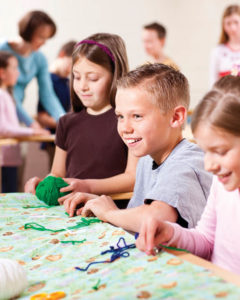Primary is for children ages three to eleven. In addition, there is a nursery for children from eighteen months until they are old enough to attend the regular Primary classes.
 Children are assigned to classes based on their ages. In smaller wards (congregations), some age groups may be combined. Class assignments are based on the age on the last day of the year, so when you take them to the Primary room, you will be asked how old they are and if they’ve already had their birthday. This helps the leaders place the children into the correct class.
Children are assigned to classes based on their ages. In smaller wards (congregations), some age groups may be combined. Class assignments are based on the age on the last day of the year, so when you take them to the Primary room, you will be asked how old they are and if they’ve already had their birthday. This helps the leaders place the children into the correct class.
There are several parts to Primary. Opening or Closing Exercises are held, based on the schedule of the Primary. Here, the children sing a few songs, honor birthdays and welcome visitors. Your children may be asked to come up front while the other children sing a welcome song. If they are shy, they can simply stay in their seats. Children are assigned to say the prayer, read a scripture, and give a two-and-a-half minute talk on a gospel principle. If your child is asked to do one of these things after a time, you will be contacted and asked permission. If you want your child to have a turn but need help, let the leaders know. Most children have someone helping them give the prayer and the scripture and a leader will be happy to help you put together a talk.
Sharing Time is a time when all or some of the classes come together in the large Primary room. Some wards divide the children into Junior and Senior Primary, based on classes. Others have both groups together, particularly in smaller Primaries. Sharing Time is based on a monthly theme, which can be found at LDS.org.
Children also attend a forty minute class, with one or two teachers and the other children in their assigned class. There are manuals for each class, which are available online at LDS.org, so you can read them at home, understand what your children are learning, and reinforce the material during the week. Teachers don’t always cover all the material in each lesson, since they select the materials best suited to their classes. Ask the presidency to tell you the manual your children are using. Generally, the nursery and Sunbeam-4 class (children who will be four at the end of the year) use the same manual, which covers very basic gospel principles and have a great deal of movement and activity. The children who will be five through eight by the end of the year use another manual. There are two manuals for this age group and the children get each one in alternating years. One year they learn the Bible, and the next they learn the Book of Mormon and church history. The older children rotate through a four year plan covering all the scriptures used by the church, one year for each book (Old Testament, New Testament, Book of Mormon, Doctrine and Covenants.)
The lessons for the younger children tend to focus on basic principles of the gospel important to children: loving your family, valuing Heavenly Father’s creations, obeying parents, and treating others with kindness, for example. The scripture stories are used to illustrate these principles. The lessons for the older children are more like a traditional Sunday School lesson, focusing on specific scripture stories and teachings.
The children also have the opportunity to participate in weeknight activities after they turn eight. The boys join the Boy Scouts of America and the girls have Activity Days. There are also larger activities, usually held on Saturday mornings, held once each quarter. These are for all children who are three and older, but not attending nursery.
To learn more about Primary, visit LDS.org. If you need help understanding the lessons your child is being taught, ask the missionaries or the Primary President for assistance. The purpose of Primary is to support the family in the teaching of the gospel, not to replace the family, so the Primary presidency is always happy to help you learn to teach your children.
If you are worried about sending your child to an unfamiliar program, you are generally welcome to visit the Primary with your child the first week. This allows you to see for yourself what your children are learning and who is teaching them. Building a relationship with the teacher helps your child feel more at home and also helps you feel comfortable leaving your child so you can attend your own classes in future weeks. Let the teacher know you aren’t a member of the church or are new, so she can take greater care to explain principles that will be new to your child.
About Terrie Lynn Bittner
The late Terrie Lynn Bittner—beloved wife, mother, grandmother, and friend—was the author of two homeschooling books and numerous articles, including several that appeared in Latter-day Saint magazines. She became a member of the Church at the age of 17 and began sharing her faith online in 1992.


